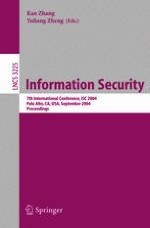The 2004 Information Security Conference was the seventh in a series that started with the Information Security Workshop in 1997. A distinct feature of this series is the wide coverage of topics with the aim of encouraging interaction between researchers in di?erent aspects of information security. This trend c- tinuedintheprogramofthisyear’sconference.Theprogramcommitteereceived 106 submissions, from which 36 were selected for presentation. Each submission was reviewed by at least three experts in the relevant research area. We would liketothankalltheauthorsfortakingtheirtimetopreparethesubmissions,and wehopethatthosewhosepapersweredeclinedwillbeableto?ndanalternative forum for their work. We were fortunate to have an energetic team of experts who took on the task of the program committee. Their names may be found overleaf, and we thank them warmly for their time and e?orts. This team was helped by an even larger number of external reviewers who reviewed papers in their particular areas of expertise. A list of these names is also provided, which we hope is complete. We would also like to thank the advisory committee for their advice and s- port.TheexcellentlocalarrangementswerehandledbyDirkBalfanzandJessica Staddon. We made use of the electronic submission and reviewing software s- plied by COSIC at the Katholieke Universiteit Leuven. Both the software and the ISC 2004 website were run on a server at UNC Charlotte, and were perfectly maintained by Seung-Hyun Im. We also appreciate assistance from Lawrence Teo in editing the proceedings.
